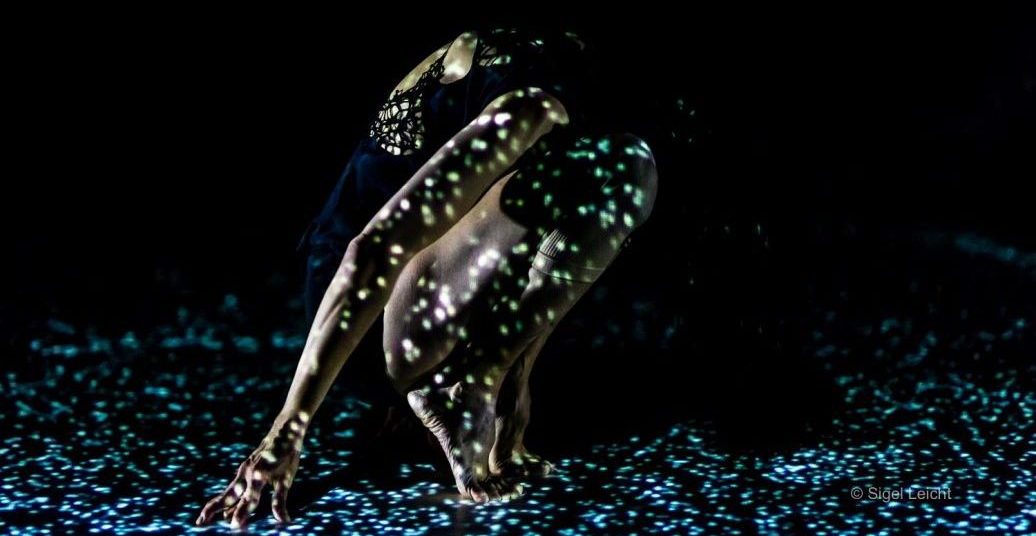“Vogel | 4 Solos” is a sequence of four solos, directed and choreographed by Christine Bonansea, and filmed at DOCK 11. Led by a powerful blend of stark lighting design and raucous soundscapes, this work aims to embody Michel Foucault’s notion of the utopian body — a daunting task for a string of four separate filmed solos that had been initially devised as simultaneous performances amongst which spectators could carve their own paths. Bonansea faces this challenge with a blast of power and creates a thought-provoking study on the limits of emotional perception.
In “Utopian Body” Michel Foucault writes: ‘Incomprehensible body, penetrable and opaque body, open and closed body, utopian body. Absolutely visible body, in one sense. I know very well what it is to be looked over by someone else, from head to toe.’ This reads as a perfect description of any body on stage — porous and open to our gaze and appraisal. In her four solos, however, Christine Bonansea explores the experience of a utopian body from within. The body here is a watchtower, a place from which the subject explores and probes the space around it — an ‘emotional container’ of agencies and feelings.
The first solo, performed by Bonansea herself, already reveals the concept and structure of the show. I am immediately struck by intricate light sculptures projected onto the black stage — puddles and circles of burning electric light pulsating, intersecting, and swallowing the performer’s body. The movements are quiet, solemn, cautious. Clad in black, Bonansea explores the space with swift touches and slow undulations, her elegant dance patterns stamped with long pauses during which my attention is stolen by the mesmerising, space-shifting light work. The ensuing solos develop at a faster pace and with a more straightforward choreography. Indistinct ghostlike silhouettes float on the brick walls of DOCK 11. Square white patterns breathe and pulsate continually on the black stage floor. A bright spotlight randomly flickers, making it difficult at times to follow the show. But then the dance also becomes more intense.
The second solo, performed by Yuri Shimaoka, relies heavily on a post-modern dance heritage and unravels into an emotional portrait of a caged bird. The third starts with Yeri Anarika descending wistfully from a brick window sill before bursting into a dramatic exploration of emotions and agencies that had been suppressed until then. Suddenly, the gestures become faltering and fragile: repetitive head shakes with arms held aloft. When Anarika’s whole body is streaked with grids of light, it produces a very powerful image.
“Vogel | 4 Solos” showcases Bonansea’s rich and thoughtful dance vocabulary as well as her masterful use of sound and light as partners to the choreography. The drawbacks of the piece essentially come from the production roadblocks: dance patterns very soon become repetitive, due to the fact that, as Bonansea explains, these solos were never supposed to be shown separately as a sequence. Performed simultaneously, they would rather communicate and rhyme with each other, allowing visitors to craft their own vision and path through the work. While it is obvious that “Vogel | 4 Solos” presents itself as a work in progress, its new filmed version is also firmly on track.
Watching filmed dance pieces always makes me think of two things. The first is usually something we take for granted: how does the dancer enter and leave the stage? No answer here, it’s just a video. The second one is more direct: would I want to see this piece again but in a theatre? With “Vogel | 4 Solos”, the answer is certainly a yes.
More information about this work and current dates can be found on the website of the artist: CBC – Christine Bonansea Company.
Vogel | 4 Solos — Choreography and direction: Christine Bonansea — Performance: Yeri Anarika, Laura Cornejo, Yuri Shimaoka, Christine Bonansea — Music: Jorge Bachmann (for Yuri Shimaoka and Laura Cornejo), Byungseo Yoo (for Yeri Anarika and Christine Bonansea) — Video Design: Lucas Kuzma — Light and visual design: Shaly Lopez — Production Manager: Tomoya Kawamura — Light: Dani Paiva de Miranda — Production: CBC – Christine Bonansea Company — Video: Walter Bickmann.




